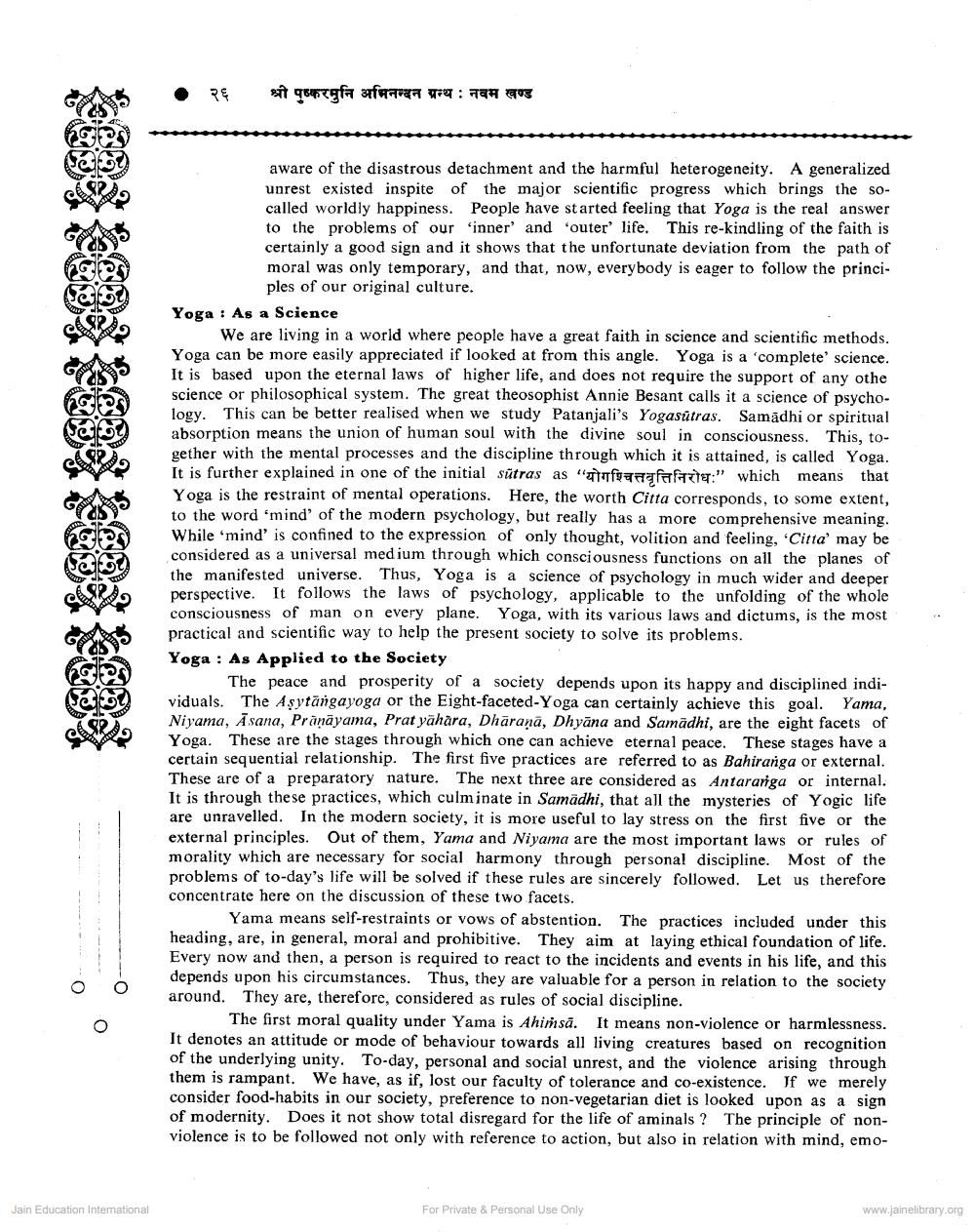________________
M
. २६
श्री पुष्करमुनि अभिनन्दन ग्रन्थ : नवम खण्ड
aware of the disastrous detachment and the harmful heterogeneity. A generalized unrest existed inspite of the major scientific progress which brings the socalled worldly happiness. People have started feeling that Yoga is the real answer to the problems of our 'inner' and 'outer' life. This re-kindling of the faith is certainly a good sign and it shows that the unfortunate deviation from the path of moral was only temporary, and that, now, everybody is eager to follow the princi
ples of our original culture. Yoga : As a Science
We are living in a world where people have a great faith in science and scientific methods. Yoga can be more easily appreciated if looked at from this angle. Yoga is a complete science. It is based upon the eternal laws of higher life, and does not require the support of any othe science or philosophical system. The great theosophist Annie Besant calls it a science of psychology. This can be better realised when we study Patanjali's Yogasūtras. Samadhi or spiritual absorption means the union of human soul with the divine soul in consciousness. This, together with the mental processes and the discipline through which it is attained, is called Yoga. It is further explained in one of the initial sütras as "Tarafafatter:" which means that Yoga is the restraint of mental operations. Here, the worth Citta corresponds, to some extent, to the word 'mind' of the modern psychology, but really has a more comprehensive meaning. While.mind' is confined to the expression of only thought, volition and feeling, 'Citta' may be considered as a universal medium through which consciousness functions on all the planes of the manifested universe. Thus, Yoga is a science of psychology in much wider and deeper perspective. It follows the laws of psychology, applicable to the unfolding of the whole consciousness of man on every plane. Yoga, with its various laws and dictums, is the most practical and scientific way to help the present society to solve its problems. Yoga : As Applied to the Society
The peace and prosperity of a society depends upon its happy and disciplined individuals. The Asytāngayoga or the Eight-faceted-Yoga can certainly achieve this goal. Yama, Niyama, Asana, Prānāyama, Prat yāhāra, Dhāraṇā, Dhyāna and Samadhi, are the eight facets of Yoga. These are the stages through which one can achieve eternal peace. These stages have a certain sequential relationship. The first five practices are referred to as Bahirariga or external. These are of a preparatory nature. The next three are considered as Antarariga or internal. It is through these practices, which culminate in Samadhi, that all the mysteries of Yogic life are unravelled. In the modern society, it is more useful to lay stress on the first five or the external principles. Out of them, Yama and Niyama are the most important laws or rules of morality which are necessary for social harmony through personal discipline. Most of the problems of to-day's life will be solved if these rules are sincerely followed. Let us therefore concentrate here on the discussion of these two facets.
Yama means self-restraints or vows of abstention. The practices included under this heading, are, in general, moral and prohibitive. They aim at laying ethical foundation of life. Every now and then, a person is required to react to the incidents and events in his life, and this depends upon his circumstances. Thus, they are valuable for a person in relation to the society around. They are, therefore, considered as rules of social discipline.
The first moral quality under Yama is Ahimsa. It means non-violence or harmlessness. It denotes an attitude or mode of behaviour towards all living creatures based on recognition of the underlying unity. To-day, personal and social unrest, and the violence arising through them is rampant. We have, as if, lost our faculty of tolerance and co-existence. If we merely consider food-habits in our society, preference to non-vegetarian diet is looked upon as a sign of modernity. Does it not show total disregard for the life of aminals? The principle of nonviolence is to be followed not only with reference to action, but also in relation with mind, emo
Jain Education International
For Private & Personal Use Only
www.jainelibrary.org




